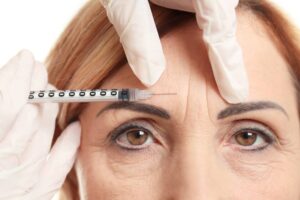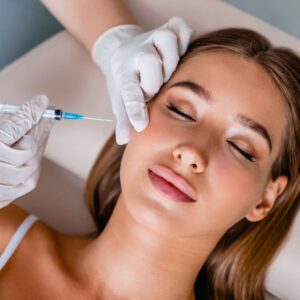Information about some common non-surgical cosmetic procedures, including Botox, fillers and microdermabrasion.
*Microdermabrasion
Microdermabrasion is a cosmetic procedure that uses fine crystals and a vacuum to remove dead skin cells. It can be used on the face, neck, chest, back and hands.

Microdermabrasion should not cause any skin colour changes or scarring. It does not work for more significant scarring, stretch marks or deep wrinkles.
It may also not be suitable for everyone. Your practitioner will be able to tell you if microdermabrasion is suitable for you or whether an alternative treatment would be better.
What to think about before you have microdermabrasion
Be aware that microdermabrasion can be expensive and has its limitations.
Cost
The cost of microdermabrasion depends on the areas of the body being treated and the number of treatments needed.
Safety
Having microdermabrasion is usually safe if it’s done by an experienced and suitably qualified practitioner.
Check the person doing the procedure is on a register to show they meet set standards in training, skill and insurance.
Avoid practitioners who have only completed a short training course.
What microdermabrasion involves
Local anaesthetic is not necessary when having microdermabrasion.
The practitioner moves a handheld device over your skin. Tiny crystals remove dead skin cells and they’re vacuumed away.
It usually takes between 30 and 60 minutes.
Afterwards
The side effects of microdermabrasion, such as redness and swelling, tend to be short-lived.
Your skin may be dry and flaky for a day or 2, or longer if you have sensitive skin. You may also have some slight bruising.
Your skin will be more sensitive to the sun afterwards, so you should avoid sun exposure for a few days and use sunscreen.
*Botulinum toxin injections, such as Botox
Botulinum toxin injections, such as Botox, relax the muscles in your face to smooth out lines and wrinkles, such as crow’s feet and frown lines.

In the UK, the cost of botulinum toxin injections can vary from about £100 to £350 for each treatment, depending on the clinic and the area being treated.
Botulinum toxin injections for cosmetic reasons are not available on the NHS.
What to think about before having botulinum toxin injections
If you’re thinking about having botulinum toxin injections, be clear about why you want them.
Make sure the person doing your injections is suitably qualified and experienced.
They should be a medical practitioner and on a register to show they meet set standards in training, skill and insurance.
Avoid practitioners who have no training or have only completed a short training course.
When you meet the practitioner, ask about:
- their training, qualifications and experience
- the name of the product, if it’s licensed, and how and where it’s made
- any risks or possible side effects
- what will happen if things go wrong
- what insurance cover they have
Botulinum toxin can only be prescribed in a face-to-face meeting by a qualified medical practitioner, such as a doctor, dentist, pharmacist prescriber or nurse prescriber.
The person prescribing botulinum toxin is responsible for making sure it’s given safely. They might not give the injections, but they should make sure it’s done by a qualified and experienced practitioner.
When you cannot have botulinum toxin injections
In certain circumstances, botulinum toxin injections are not recommended, including if:
- you have a skin infection
- you’re unwell in any way
- you have a neuromuscular condition like myasthenia gravis
- you’re taking certain medicines
- you’re pregnant or breastfeeding
What having botulinum toxin injections involves
Your face will be cleaned and botulinum toxin will be injected into muscles in your face using a very fine needle.
You will need injections in different places, depending on the area being treated. The practitioner will ask you to move the muscles in your face to help find the best place for the injections.
It usually takes about 10 minutes.
Afterwards
You will not see a change straight away. It takes about 2 or 3 days to start working, and 2 to 3 weeks to see the full effect.
Do not massage or rub your face for 3 days. Also, avoid vigorous exercise, sunbathing (including using sunbeds), and the sauna for 2 days. Your practitioner should be able to give you more advice about what you should and should not do.
The effects usually last for about 3 or 4 months. If you have botulinum toxin injections again, you should wait at least 3 months. It might stop working if you have it too often.
Risks
The risks of botulinum toxin injections are small if it’s done correctly by a suitably qualified practitioner. Speak to your practitioner about the risks.
After treatment you may have:
- a headache and flu-like symptoms for the first 24 hours
- bruising, swelling and redness where the needles went in the skin
- a frozen look – you might not be able to move the muscles in your face if too much botulinum toxin is injected
- temporary weakness and droopiness in your face – for example, your eyelids or eyebrows may droop if the botulinum toxin moves into these areas
Very rarely, serious problems such as blurred or double vision can happen if the area around the eyes is treated, or breathing difficulties if the neck area is injected.
*Laser hair removal
Laser hair removal is a cosmetic procedure that uses a powerful laser or intense pulsed light (IPL) to remove unwanted hair.

Common areas to treat are the face, chest, legs, arms, underarms and bikini line.
It can be helpful for women with excessive hair growth (hirsutism).
What to think about before you have laser hair removal
Laser hair removal may have side effects, it has limitations, and it can be expensive.
Safety
Laser hair removal is safe, but it can occasionally cause side effects, such as pain and discomfort, and red skin that may last for some time.
It may also not be suitable for everyone, including pregnant women and people with certain skin types.
There’s no evidence to suggest that laser hair removal causes skin cancer.
It’s important to make sure the person doing your laser hair removal is experienced and suitably qualified.
Check they’re on a register to show they meet set standards in training, skill and insurance.
Avoid practitioners who have only completed a short training course.
It’s not permanent
You’ll need regular sessions to keep hair from regrowing.
How often sessions are needed varies for each person. For example, you may need a session to remove facial hair every 4 weeks, and for body hair every 6 to 8 weeks.
There’s no guarantee laser hair removal will get rid of all the hair.
It does not work well on dark skin
Laser hair removal works better on people with pale skin and dark hair.
It’s not as effective on tanned skin or hair that’s been bleached by the sun. If you’ve got a tan you’ll need to let it fade before having treatment.
Cost
The cost of laser hair removal depends on the area of the body being treated and the number of treatments needed.
What laser hair removal involves
You’ll need to shave the area of skin the day before your appointment.
On the day, you’ll wear specially designed goggles to protect your eyes.
The practitioner usually applies a cool gel or cooling air spray to the area of skin.
They then press a handheld device to your skin and trigger the laser. This may feel like an elastic band snapping at your skin.
Each session may take between 15 minutes to over an hour.
The number of sessions needed depends on the area to be lasered and the system used.
Afterwards
The affected area may be red with a raised rash for a few hours to a few days.
Regularly holding an ice pack to the skin may help (try a pack of frozen peas wrapped in a tea towel).
Your skin will be more sensitive to the sun after laser hair removal. It’s best to avoid exposing the treated area of skin to sunlight until after the treatment course has finished.
Regardless of the weather, use sunscreen (minimum SPF30) for at least 4 weeks on exposed areas that have been treated.
Rarely, laser hair removal can result in:
- pain, discomfort or tenderness
- red skin that may last for some time
- crusting, blistering, bruising or swelling of your skin
- lightening or darkening of your skin
- scarring
- burns from the laser’s heat
- bacterial infections
*Face and lip fillers (dermal fillers)
Face and lip fillers (dermal fillers) are substances injected into your face. They fill lines and wrinkles and add volume to areas such as your lips or cheeks.

Most dermal fillers used in the UK contain a natural substance called hyaluronic acid.
If you have fillers, the rest of your face will continue to age as normal.
What to think about before you have face and lip fillers
If you’re thinking about having dermal fillers, be clear about why you want them.
Having dermal fillers is usually safe if it’s done by an experienced and suitably qualified practitioner.
Check the person doing your dermal fillers is on a register to show they meet set standards in training, skill and insurance.
Avoid practitioners who have only completed a short training course.
Book a consultation before you have the procedure.
Ask about:
- the practitioner’s experience and qualifications
- the name of the product and how and where it’s made
- any risks or possible side effects
- what will happen if things go wrong
- what insurance cover they have
What happens when you have face and lip fillers
An anaesthetic cream might be used first to numb your skin. Injections are given around the area of your face being treated, which is then massaged.
It might feel uncomfortable but should not be painful.
The treatment usually takes between 20 and 30 minutes, depending on the area being treated.
Afterwards
The affected area may be a bit red, sore and swollen. Any swelling or bruising should settle down in a few days.
You should be advised about what to do to help reduce the risk of side effects.
This includes not wearing make-up immediately after the procedure and avoiding alcohol, coffee and the sun.
Risks
The risks of dermal fillers depend on whether the procedure was done correctly and the type of filler used. Speak to your practitioner about the risks.
Serious problems are rare but can include:
- infection
- a lumpy appearance under the skin, which might need to be treated with surgery or medicine
- the filler moving away from the intended treatment area, which may need to be removed using surgery
- scarring
- blocked blood vessels in the face, which can cause tissue death and permanent blindness